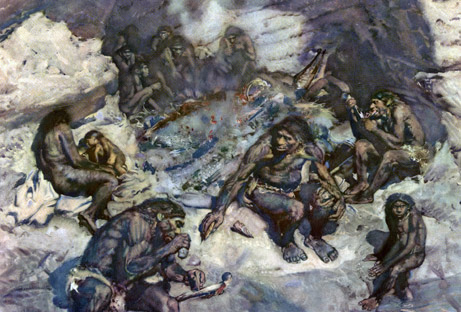
[ "Ghoul on a meal." by Arjen E. Pilon from http://www.elfwood.com/]
GHOUL
Definition from Wikipedia:
http://en.wikipedia.org/wiki/Ghoul
"A ghoul is a folkloric monster associated with graveyards and consuming human flesh, often classified as undead. The oldest surviving literature that mention ghouls is likely One Thousand and One Nights. The term is first attested in English in 1786, in William Beckford's Orientalist novel Vathek,[1] which describes the ghūl of Arabian folklore.
Early etymology
Ghoul is from the Arabic ghul, from ghala 'to seize'[2].Marc Cramer and others believe the term to be etymologically related to Gallu, a Mesopotamian demon[3][4]
In Arabian folklore
In ancient Arabian folklore, the ghūl (Arabic: غول , literally demon)[5] dwells in burial grounds and other uninhabited places. The ghul is a devilish type of jinn believed to be sired by Iblis.[6]
The Arabian ghoul is a desert-dwelling, shapeshifting demon that can assume the guise of an animal, especially a hyena. It lures unwary travellers into the desert wastes to slay and devour them. The creature also preys on young children, robs graves, drinks blood, steals coins and eats the dead,[5] taking on the form of the one they previously ate.
In the Arabic language, the female form is given as ghouleh[7] and the plural is ghilan. In colloquial Arabic, the term is sometimes used to describe a greedy and/or gluttonous individual."
[Ghool, AKA Rakshasa]
--On the other hand, Cryptozoologists have inferred the name is not Arabic at all, nor is it Iranian (in which "Ghul" means a rose) It is Turkic and part of a well-known cluster of names for the "Wildman" of Turkestan and the Near East, Gulub-Yavans (As Gordon Creighton points out, the "Yavani" means "Wild" in Turkic and the name means "Wild Man") Heuvelmans records that the term of Ghul or Gul alone (in some sources spelled Ghool) is in usage in places.
In other words, the Wildman acquired a reputation of digging up dead bodies in order to eat them, a habit otherwise ascribed mainly to jackals and hyenas. Hence the Wildman is sometimes said to be able to transform into these animals.

It would seem that the Wildman or Neanderthal type has a habit of eating the dead of their own kind and there are occasions when a dead body of an Almas (or one of the American Almases) is buried with a mind for witnesses to dig it up again as evidence, only to find the body has been dug up again when they DO get back to recover it. Presumably other Almases have dug up the body in order to eat it.


[Ghool Footprint] {Neanderthal Footprint 1950]
There is evidence for cannibalism at certain Neanderthal sites where their bones have been scraped with stone knives in getting the meat off them, and the bones treated the same as other kitchen refuse. It would seem that the usual practice among Almases is to eat already-dead corpses, but some of the larger ones (called variously Trolls, Orcs [Orcos], Onis or Ogres) are traditionally said to seize and eat humans, in particular small children, with a preference for young boys. That may have happened occasionally but there are no known cases of this still going on as a regular occurance.
The same thing might be said to be true about sasquatches, except that traditionally the size of the human prey is no matter and they will go after adults just the same as after children. For this reason it is probably a mistake to flatly discount stories about the "Cannibal Giants" even if humans are not ordinarily on the menu for sasquatches much any more. But THEY also seem to eat the dead of their own kind as well, and also they seem to preferentially seek out dead bears when they can find them. In North America, sasquatches will steal deer carcasses from hunters regularly, and the association with sasquatches stealing deer meat is one of the more definite recurring indicators of what their diet usually is.



















No comments:
Post a Comment